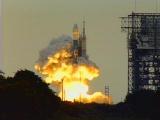
MEDIA RELATIONS OFFICE JET PROPULSION LABORATORY CALIFORNIA INSTITUTE OF TECHNOLOGY NATIONAL AERONAUTICS AND SPACE ADMINISTRATION PASADENA, CALIF. 91109. TELEPHONE (818) 354-5011 http://www.jpl.nasa.gov
Mars Polar Lander Mission StatusJanuary 3, 1999Mars Polar Lander -- due to become the first spacecraft to set down near the edge of Mars' southern polar cap -- pierced through a blustery, cloud-covered Florida sky at 3:21 p.m. Eastern Standard Time today atop a Delta II launch vehicle from Cape Canaveral Air Station's Launch Complex 17B. The spacecraft, launched successfully on the first day of the launch period, is equipped with a robotic arm to dig beneath the layered terrain of the Martian polar region and two microprobes to crash into the planet's surface and conduct two days of soil and water experiments up to 1 meter (3 feet) below the Martian surface.
Sixty-six seconds after liftoff, the Delta's four solid-rocket strap-on boosters were jettisoned. Firing of the main first-stage engine lasted approximately 4 minutes, 24 seconds. Eight seconds later, the first stage was discarded, and 5.5 seconds later the second stage ignited. Four and a half seconds after that, the nose cone surrounding the lander was jettisoned. The second-stage burn lasted 6 minutes, 44 seconds and placed the spacecraft into a low-Earth orbit at an altitude of 191 kilometers (119 miles). The spacecraft coasted over the Indian Ocean for approximately 23 minutes before the second stage engine fired briefly a second time. The third stage fired for 88 seconds at 3:57 p.m. EST to propel the spacecraft out of Earth's gravity and on its way to Mars. At 4:03 p.m. EST, Mars Polar Lander separated from the third stage. A set of solar panels located on the spacecraft's outer cruise stage were deployed shortly thereafter and pointed at the Sun. At 4:19 p.m. EST, the lander's signal was acquired by a 34-meter-diameter (112-foot) antenna of NASA's Deep Space Network in Canberra, Australia. Mars Polar Lander's interplanetary cruise to Mars will take it more than 180 degrees around the Sun in what is called a Type 2 trajectory, allowing the spacecraft to target a landing zone close to Mars' south pole at 73 to 76 degrees south latitude. Throughout the cruise, the spacecraft will communicate with Earth using its X-band transmitter and medium-gain horn antenna mounted on the cruise stage. During the first 30 days of flight, the spacecraft will be tracked 10 to 12 hours per day. Quiet phases of the trip will require only four hours of tracking time each day. The spacecraft is scheduled to fire its thrusters in a trajectory correction maneuver January 18. That maneuver is designed to remove a targeting bias intended to prevent the third stage of the Delta II rocket from following in the lander's flight path and colliding with Mars, as well as any small launch injection errors. That maneuver is expected to take approximately 5 minutes to execute. Mars Polar Lander is the second of two spacecraft launched to the red planet during the December 1998-January 1999 Mars launch opportunity. Mars Climate Orbiter was launched December 11, and is scheduled to reach Mars next September 23. Onboard Mars Polar Lander are two microprobes developed as the Deep Space 2 project under NASA's New Millennium Program. The Deep Space 2 probes will smash into the Martian surface as a test of new technologies for future planetary descent probes. |
| Home | Mars Polar Lander | Deep Space 2 Microprobes | Mars Climate Orbiter |
| Welcome | Mailing List | Links | Credits |
For questions or comments on this website please refer to our list of contacts.
